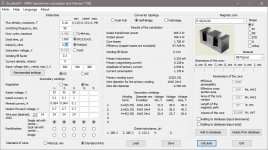Hello,
I am a third year Electrical Engineering student. I am interested in designing and building my first smps and figured this would be the best place to get a start. I have studied smps topologies for some time now but lack some knowledge in computations.
Here are some design parameters that I am looking to achieve:
Input: 120V nominal @ 60 Hz (No voltage doubler needed)
Output: 2 X 32V @ 150W each.
I was considering a push-pull topology, but I do not fully understand how to design the current-mode feedback loops.
Any help is appreciated. If this project would be too complex for a first project then I am open to considering a different topology for my first design experience.
- Brady
I am a third year Electrical Engineering student. I am interested in designing and building my first smps and figured this would be the best place to get a start. I have studied smps topologies for some time now but lack some knowledge in computations.
Here are some design parameters that I am looking to achieve:
Input: 120V nominal @ 60 Hz (No voltage doubler needed)
Output: 2 X 32V @ 150W each.
I was considering a push-pull topology, but I do not fully understand how to design the current-mode feedback loops.
Any help is appreciated. If this project would be too complex for a first project then I am open to considering a different topology for my first design experience.
- Brady

